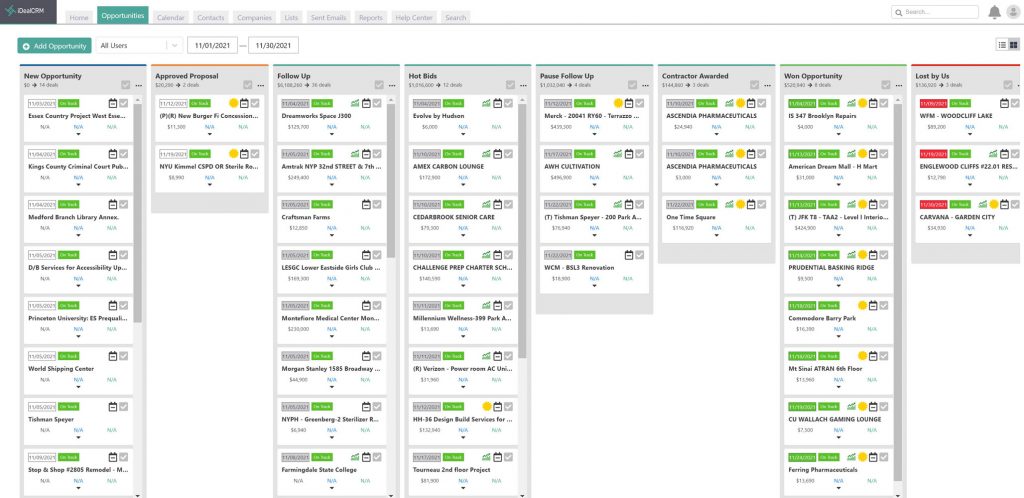Not only do seasoned construction sales executives know how to set goals, but experience has taught them it is both Science and Art. Setting sales objectives requires a great deal of knowledge of your territory, customer needs, and competitive landscape. And many years’ experience in setting and meeting goals. It also requires vision, creativity, and the ability to connect the dots.
Our article will demonstrate how to incorporate both approaches into actionable and inspirational sales goals for your construction sales team. And, most importantly, how to make them achievable.

Why Setting Goals Is Important
If you’re wondering why setting goals is so important, consider this:
- Goals help your sales team (and any other team for that matter) prioritize their work, plan their time, and keep them on track to reach their quotas.
- Performance goals keep every member of your team accountable. And accountability is crucial in meeting sales targets.
- Goals help your team visualize the end result. Visualization is one of the most powerful tools for humans to achieve their goals.
- There’s no better tool to keep your sales team motivated than setting specific and measurable goals.
- As the year progresses, you may need to adjust goals, accelerate the timeline, or set new ones. This is a natural part of planning and you need to recognize when your sales team’s goals need to be adjusted to keep moving forward towards achieving your target revenue.

“When 10%–20% of salespeople miss goals, the problem might be the salespeople. But when most salespeople miss them, the problem is their goals.” – Harvard Business Review.

The Science of Setting Sales Goals
Let’s be clear, the Science or shall we say the Math behind sales goals is by no means clear cut or precise. But it provides a solid foundation to build or grow your business, plus it provides credibility for the Art of setting sales goals. Here are a couple of best practices:
1. Set Sales Goals Based on Target Revenue
Before you establish sales goals for your construction team, you need to pin down your target revenue. Look at your past year of sales and take that historical data into account along with other considerations. For example, consider who your best sales reps were and if they’re still with you. Or who your best-performing clients were and if your relationship with them is still going strong. Another important aspect is analyzing your sales data from existing clients and new client sales separately and setting sales goals for each.
2. Establish Sales Goals Based on Type of Work or Service Sold
This is part of your target revenue analysis but it’s worth mentioning it on its own. When you analyze the previous year’s revenue, create separate buckets for each source as different estimators, sales people, or business developers are probably responsible for it. For example, an estimator in large contracts will have a bigger quota than one in small contracts. Also business developers responsible for bringing in new clients should have separate quotas and they should be based on the past year and this year’s growth target.
3. Adjust Sales Goals Based on Forecasting
As sales start coming in, you can better forecast your current year’s revenue. Adjust your sales goals based on your sales forecasting. If you are interested to learn more about sales forecasting, please read our comprehensive article on sales forecasting definition, requirements, and methods, including examples. You may also be interested to know exactly what the benefits of sales forecasting are. At any rate, it will support you to set realistic sales goals.
4. Set SMART Goals – Make Sales Goals Specific, Measurable, Achievable, Realistic, and Time-based
There are as many ways to set sales goals as there are sales profiles. But regardless of the method chosen, the end result needs to be a SMART goal. They are clear, concise, and measurable. The first thing to do when setting sales goals is to understand what type of goals are achievable. This means setting goals that are specific, clear, and relatable. In other words, goals that will enable your sales team to measure their collective and individual progress and identify areas for improvement if/where necessary.
- SPECIFIC – Describe exactly what you are measuring and how it can be achieved.
- MEASURABLE – Give actual quantities and percentages. Don’t use vague language.
- ACHIEVABLE – Base your goals on past performance. Don’t make them overly challenging.
- REALISTIC – Make sure they align with the overall organization strategy and vision.
- TIME-BASED – Set realistic timelines for each goal to be reached.
Examples of SMART Goals for Construction Sales Teams
- Increase the number of proposals sent out by 15% by the end of Q2
- Send out 50 follow-up emails a month
- Increase closing rate by 10% by the end of Q2
- Improve closing rate for clients with a 30-40% rate to 60-75% closing rate by end of year (these are the clients you can deepen your relationship with in order to bring more market share)
- Bring 20% more new business than last year (good goal for the business development team for a company looking to grow)
- Acquire x amount of clients from a new market you are looking to enter this year
5. Arm Your Sales Team with the Necessary Software Tools
Goals give meaning to your sales pipeline, but without the proper tools to track and measure them, goals are just text on a paper.
A Sales and Pipeline Management Software is one of the best tools you can arm your construction sales team with in order to achieve their goals. Not only does it organize their opportunities, leads, and clients, but it also provides reports against quotas and helps your team prioritize work and meet deadlines. With a pipeline management software and goals set in place, your construction sales team has all the necessary tools to achieve and surpass their quotas.. Here’s how this type of software plays such an important role in achieving goals:
- Organizes and prioritizes all your leads, bids & opportunities on a pipeline board
- Maintains comprehensive client profiles (open and closed deals, tasks, comments) so you can identify opportunities of growth
- Creates, sends and tracks branded proposals (multiple proposals at a time)
- Provides a construction calendar with bids, follow-ups, tasks, and events, all in one
- Supports reporting and quota tracking on a weekly, monthly, quarterly, and yearly basis.
- To name but a few…
6. Reward Sales Achievements
We don’t have to tell you rewards are part of the Science of setting sales goals. It is a tangible way of achieving the sales goals you’ve set for yourself and your team. Rewards don’t just have to be monetary, or for that matter, focused on $ sales. Reward the right behaviors too, not just stretch goals. For example, reward anniversaries, repeat customers, and job upgrades. And fit the reward to the sales personality. Some execs may prefer a weekend away with their family at a resort, not a fat check.

The Art of Setting Sales Goals
Missing goals can be stressful and fearful and… squash motivation, the exact opposite of what you want to achieve. This is where the Art of setting goals comes into play. Here are a few tried and trusted approaches to setting sales goals that are motivating and inspirational.
1. Set “Waterfall” Goals
Set waterfall goals on a team level. Ramp up the sales goal of each team member over the course of the year, e.g. add $x amount of sales to the starting goal for each salesperson every quarter. It does not overwhelm individuals or the team as a whole. It also allows you to offset misses and gains for the team, so if someone lags and someone scores, the team is still ahead and… remains motivated.
2. Establish Priority Goals
Give your sales team goals that are not necessarily dollar focused, but will get them there. It’s also called “activity selling”. Make sure they avoid chasing unprofitable deals, and know what to do to deliver sales results. It is not just important to qualify leads and sell them, but close the deal. At some point of the sales pipeline, there should be a “Go/No Go” stage to measure effort against time to convert, so one can divert your attention to the deals you can close and meet your sales goal. The “big fish” can stay in the water; they typically take longer to convert anyway.
An example goal would be to identify X number of qualified leads and set up three sales appointments per week, depending what the conversion ratio (Science!) at your company is. It will give them a sense of accomplishment hitting those sales quotas, and motivate them to stay at it.
3. Set Personal, Team, and Company Goals
When you make personal and team goals part of the overall company sales goals, it helps each member of your construction sales team get the big picture. Setting sales goals this way provides context and meaning that is necessary to motivate your team.
Let’s examine personal goals examples. For instance, when you say we need to close 20% more work this year, this goal is vague and lacks motivation. But when you say we are planning on expanding our services, and in order to do that, we need to close 20% more work this year. If we split it across the board, that means each salesman needs to close 4% more work this year. Let’s see how each of you can accomplish that. Those of you in large contracts, all you need to do is close 2 extra contracts. Those of you in service contracts need to close 10% more maintenance contracts. And business developers need to bring in 10 more new clients this year. Let’s see what we need to do to achieve these sales goals.
4. Invite Collaboration
Make everyone on the team take turns to revisit their experience in the field, analyze the success scenarios, and share tips and tricks with the team. They can do that on your team collaboration platform or on your standing sales calls. In other words, encourage them to think about what worked for them and what not, and repeat behaviors that produced a desired result, and share that with their peers. Or you can assign and encourage a skilled and experienced sales executive to develop their leadership skills and mentor the team.
5. Break Down Silos
Accounting and Operations depend on Sales to exist. Marketing supports Sales via lead qualification. And sales planning and operations are two sides of a coin. Bottom line, all those in marketing, sales, engineering and estimating/proposal preparation or project management play a part in converting prospects to clients and opportunities to jobs in a sales pipeline. Make sure there are no barriers between them and that they know they are on the same team. In fact, think about creating cross-departmental teams if your company is large enough to.
6. Communicate, Communicate, Communicate
Don’t just have quarterly, monthly, or weekly pow wows, talk to your team each day, or at least make sure they know they can talk to you. And LISTEN.
Communication educates and empowers. Validate your team’s strengths, and offer support in the areas they are not quite confident in. Solicit feedback and input when you set sales goals. It is so important that everyone on your sales team owns their share of the organization’s sales goals.
“Communicate unto the other person that which you would want him to communicate unto you if your positions were reversed.” ~ Aaron Goldman
How to Set Sales Goals with iDeal Construction CRM and Reach Them!
As we discussed above, arming your sales team with the appropriate tools should be an integral part of sales and operations planning. When salespeople are empowered with the tools and data they need to sell and track their sales against their quota, they are more likely to reach it.
For construction sales teams, the best way to set sales goals and track progress is by using a construction CRM or a sales management solution that fits your process. Even though small companies may think that spreadsheets are a good enough solution, they lack crucial functionality and robustness. In today’s digitized world, it is quite fast, easy, and inexpensive to implement a software system.
Let’s take some of the iDeal Construction CRM features as an example.

- Construction sales people can easily track sales quotas. You can set a different quota and profit target for each sales person.
- As your sales people enter opportunities and move them through the funnel, you can track actual sales against their sales goals.
- The forecasting functionality allows you to add the opportunities that qualify with their respective percentages, so you can accurately predict how much each sales person is going to close each month, quarter, or year.
- Construction reporting on personal and overall win rates, quota tracking, margin analysis, and forecasted revenue are the final step in setting and meeting sales goals for your construction sales team.
- Pricing is very affordable – if you’re looking for a sales management software free of charge, iDeal CRM is the solution for you. This way you can test drive all the features at your own pace without incurring any fees or obligations.
In Conclusion
As you can see, the Science sets the scene for the Art of setting sales goals. It is so important to get that right, and it is not rocket science. Sales goals based on sales forecasting, SMART goals, a CRM tool that mirrors your sales pipeline, and rewards, all go hand in hand.
Then, apply the Art of setting goals with your sales team. You will have sales goals that are realistic, clear, concise, and measurable, as well as meaningful and inspiring. In other words, sales goals that put you on top of your sales pipeline.
Best of all, now that you have the methodology down pat, setting sales goals is repeatable going forward. And easy to finetune depending on the industry you are in, economic trends, what motivates your sales team, and the business processes and technology at your organization.
Wishing you more leads, clients, and jobs going forward!
